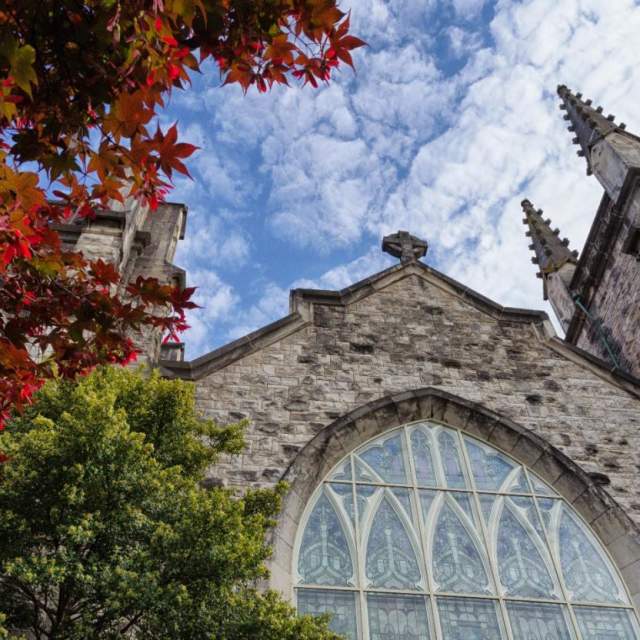Many of us enjoy seeing the architecture of a city, and houses of worship have played a major role in architecture, design, and history. From Neo-Classical columns to soaring Gothic Revival, Knoxville has a wide range of church styles in an array of denominations.
For those who travel during Easter or locals looking to visit a new house of worship for the holiday, perhaps consider one of these historic churches in Knoxville*. Several of them are on the National Register of Historic Places.
 |
 |
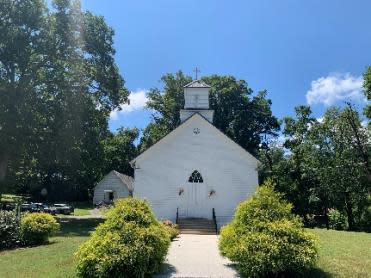 |
|
Asbury United Methodist |
Riverdale United Methodist | Bethel United Methodist |
Asbury United Methodist Church
The church in east Knox County is named for English Methodist evangelist Francis Asbury, who is credited with disseminating Methodism in the United States in late 18th and early 19th centuries, and who on November 2nd, 1800 led the first Methodist worship service in East Tennessee. The church sits on land that was donated in 1855 by the Huffaker family. The church building underwent its last major renovation in 1898. The Gothic revival architecture has been largely unaltered since that time. The church building was listed on the National Register of Historic Places in 1997. The National Register nomination referred to the "inspirational feeling" imparted by the Gothic revival architecture, the "sense of power" imparted by the church's steep gabled roof and pronounced arches, and the "sense of strength and stability" conveyed by the square bell tower, which has a bellcast roof.
This church is also on the French Broad Driving Tour, designed to take you along the river to the east side of town, where the French Broad forms a fertile valley. In this valley, many early pioneers, some of them arriving from the former colonies by flatboat, settled and raised crops and formed a community. Other churches on this tour include Riverdale United Methodist and Bethel United Methodist (the last stop before Seven Islands State Birding Park).

Church Street United Methodist
This church was established a few years after the famous Francis Asbury visited Knoxville in 1800. Asbury rode into Knoxville on November 1 and preached to 700 people on November 2. The city was only 9 years old and was the state capital at the time. It was caught in the wave of Christian “Second Re-Awakening” which was sweeping the country. The first Knoxville Methodist Church, its small frame building constructed in about 1816, was locally referred to as White’s Chapel, located on “Methodist Hill” on the east side of First Creek on what is now E. Hill Ave. In 1836, the growing biracial congregation moved into its new brick church to Church Street in downtown Knoxville, using the previous 1816 church building for educating its African American and white children.
In 1863, the 1836 church building on Church Street was confiscated by Union forces and used as a hospital, and later, to stable horses. Its congregation was without its own building for several years. Church Street reconstituted itself in 1866 and finally regained its property seven years after the end of the Civil War. In 1878, the congregation built a new Victorian Gothic Church on that property. Tragically, it was destroyed by fire in 1928. The congregation voted to build a new church on a new and larger lot on Henley Street. It was to be a beautifully constructed building in the Gothic Revival style by renowned architects Charles I. Barber of Knoxville (a member of the church) and John Russell Pope (Jefferson Memorial, National Archives Building, and National Gallery of Art West building in Washington, D.C.). The first church service in the new building was held on January 25, 1931, just 9 months and 24 days after construction had begun. This building is now a Knoxville icon and is on the National Registry of Historic Places. This downtown church can be seen while experiencing the Historic Downtown Knoxville Walking Tour.
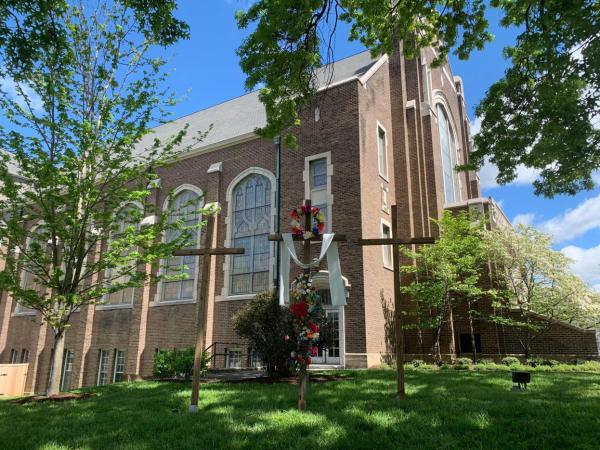
Central United Methodist Church
Central United Methodist Church was added to the National Register of Historic Places, and is listed as a contributing property within the Fourth and Gill Historic District. The church was organized in 1924 as a merger between Broad Street Methodist and Centenary Methodist churches after a fire destroyed the Broad Street building. The present structure was completed in 1927 in the Gothic Revival style. Baumann & Baumann of Knoxville were the architects. The exterior of the church is primarily brick, but also includes stone, limestone and marble. The organ was purchased from the Riviera Theater in 1935.
Also in the Fourth and Gill neighborhood is Trinity Methodist Episcopal Church (now known as Knoxville House of Faith with a Pentecostal congregation). It was built in 1906 and added to the National Register of Historic Places in 1982.

First Baptist Church
The congregation was organized in 1843 by James and John Moses. After its first baptismal service in nearby First Creek, the church had 46 members, including 20 African Americans. The first building was constructed on Gay Street in 1844. The second building was built at the same location in 1887. The third (and present) building was completed in 1923 at the Main Street location. This architecturally significant structure, noteworthy for its Neoclassical design and octagonal sanctuary, was designed by Dougherty & Gardner of Nashville, Tennessee, and is modeled on St Martin-in-the-Fields of London. This downtown church can be seen while experiencing the Historic Downtown Knoxville Walking Tour.
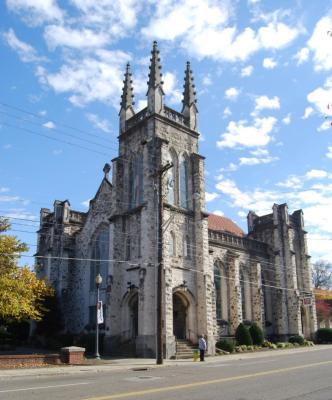
St. John's Lutheran Church
This church just north of downtown (Broadway at Emory Place) was formed in 1888 and the first English-language Lutheran congregation in Knoxville. The founding members were Lutherans of German heritage who preferred English over German, which was then used in other local Lutheran churches. Development of the current church building began in 1910 and completed and dedicated in 1912. R. F. Graf was the architect of the Gothic Revival style building; gothic elements include arches at windows and doorways, exterior buttresses, and tracery. The sanctuary is surrounded by 61 stained glass windows, including a series of nine pictorial windows that depict scenes from the Bible in chronological sequence. The church building is listed on the National Register of Historic Places, both individually and as a contributing property in the Emory Place Historic District.
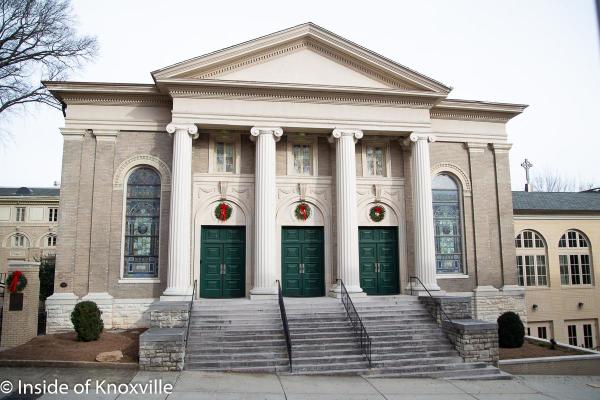
First Presbyterian | credit Inside of Knoxville
First Presbyterian
Not on the Register of Historic Places (but should be?), the first church established in Knoxville, First Presbyterian was a congregation in 1792 but did not erect a building until 1816, after Knoxville had gotten criticism from shocked visitors that the capital of Tennessee had no churches. James White, whose original fort was immediately to the north of here, donated the land, his former turnip patch, for the construction. The current church, the third on this site, was built in 1903 and designed by Knoxville’s Baumann Brothers in the Neoclassical style, with elaborate stained-glass windows, some designed by Tiffany, and much expanded from the 1920s through the 1980s.
First Presbyterian’s famous graveyard, the oldest in Knoxville proper, was here before the first church and is host to a number of prominent early Knoxvillians. Territorial Governor William Blount and his wife Mary Grainger Blount (for whom both Maryville and Grainger County are named) are here, as well as U.S. Senator and ambassador John Williams and statesman Hugh Lawson White, onetime president pro tempore of the U.S. Senate, who ran a popular campaign for the U.S. presidency in 1836; Samuel Carrick the Presbyterian minister who founded Blount College, which much later became the University of Tennessee; Margaret Humes, the thrice-widowed first owner of the Lamar House; and Knoxville founder James White. This downtown church can be seen while experiencing the Historic Downtown Knoxville Walking Tour. (copy credit to Knox Heritage)
 |
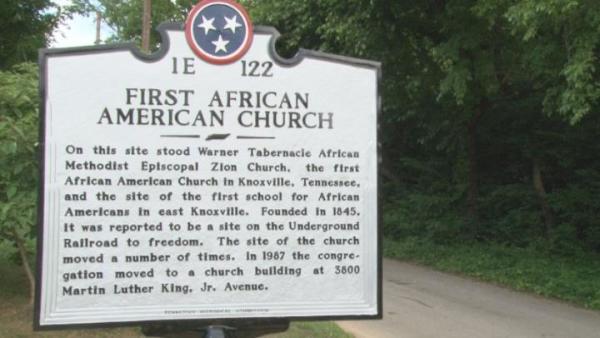 |
Greater Warner Tabernacle AME Zion Church
While not on the National Register of Historic Places, the congregation of the Greater Warner Tabernacle AME Zion Church is certainly historic. It is presently located at 3800 Martin Luther King Jr. Avenue. It was reportedly a station on the Underground Railroad.
The congregation was first established in 1845 on Fuller Street, on land donated by a religious German. This first church was known as Warner Tabernacle; the first actual building was not constructed until the late 19th century. It was destroyed by storms in 1908, and the second church was completed in 1910. In 1967, the congregation moved to Speedway Circle and its name was changed to Speedway Circle AME Zion Church. In 1969, the name was changed to Greater Warner Tabernacle. In 1987, the congregation purchased the McCalla Avenue Baptist Church and moved again. This portion of McCalla Avenue is now known as Martin Luther King Jr. Avenue. Greater Warner Tabernacle is Knoxville's oldest extant African-American church congregation.
Other churches you might have come across if you’re a music or festival lover in Knoxville:
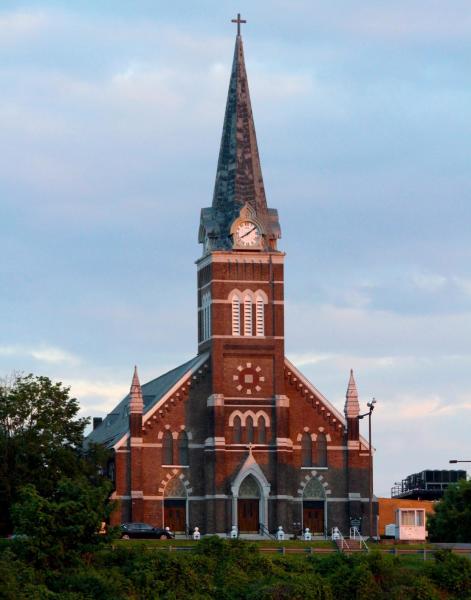
Immaculate Conception
A small number of Irish Catholics were residing in the area when the city of Knoxville was established in 1794. By 1810 there was talk of establishing a Catholic parish and building a church on the banks of the Holston River. This sparsely populated frontier had received a few visits from traveling priests, however, there was no priest available to take up residence and the plans were never realized. With the creation of the Diocese of Nashville in 1837 and the construction of the railroads in the 1840s, a new group of Irish Catholics migrated to Knoxville.
In the early 1850’s, Father Henry Brown was appointed as the first resident priest of Knoxville. In 1855, he purchased land downtown on Summit Hill at the corner of Vine Avenue and Crooked Street (now Walnut). Father Brown, a gifted artist and amateur architect, drew up the plans for the church in the Gothic Revival style. The details of the stonework, the contrasting coloring of the stones, and its graceful proportions made it an architectural gem in a town that still reflected its pioneer beginnings. All the labor for the church was done by its members, most of whom were stone and marble workers. Construction progressed swiftly and the church, perched on the highest hill in the town, was dedicated by Bishop Miles in the fall of 1855. If you’ve been to Irish Fest on the Hill, you’ve been to this church – learn more about the Irish Catholic population of Knoxville. This downtown church can be seen while experiencing the Historic Downtown Knoxville Walking Tour.

Sacred Heart
In 1952 Knoxville needed a third parish to enable the works of an expanding Catholic population. Six acres of the William Towle farm on Northshore in Bearden were purchased in 1953 with construction to follow. The official title given to the completed building was The Church of the Sacred Heart of Jesus. Father Dolan was appointed its first pastor and celebrated the first Mass in the new church at midnight, Christmas, 1956. Father Joseph Julius was pastor from 1972 to 1981, during his tenure, additions were made to the physical plant, which included the gymnasium, new school classrooms, and a school library. By this time the parish had grown to over 1,000 families. Father Julius also facilitated the formation and beginning of St. John Neumann Parish in Farragut.
In 1988 the church was named the Cathedral of the newly created Diocese of Knoxville. In 1992, 43 acres of land were purchased for a future parish to include part of Sacred Heart Cathedral parish. The new All Saints Parish began operation in 1994. The Knoxville Opera has held many performances in this beautiful cathedral, including programming as part of annual favorite Rossini Festival.
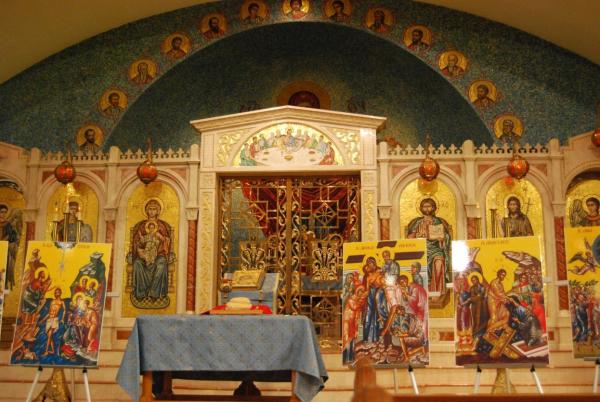
St. George Greek Orthodox Church
If you’ve ever been to Greek Fest, you’ve been to this beautiful church in Sequoyah Hills.
The beginning of the Greek Orthodox community in Knoxville dates back to approximately 1915 with the arrival of the Nicola Cazana family. Soon afterwards, many other Greek families migrated to the East Tennessee area. These immigrants wanted to preserve and to protect their Orthodox religion, Greek heritage and customs, so they formed the St. George Hellenic Community Club in 1934. By 1946, the community had grown large enough to afford its own building, so they purchased an old Baptist church on Broadway and remained there until 1968.
In order to meet the demands of a growing community, property was bought and a new church was built in Sequoyah Hills on Kingston Pike. Following the Byzantine style architecture and using beautiful mosaic icons, the new building has become a focal point of Orthodox worship in the area. Today, it houses one of the most beautiful examples of mosaic Byzantine iconography in the Southeast.
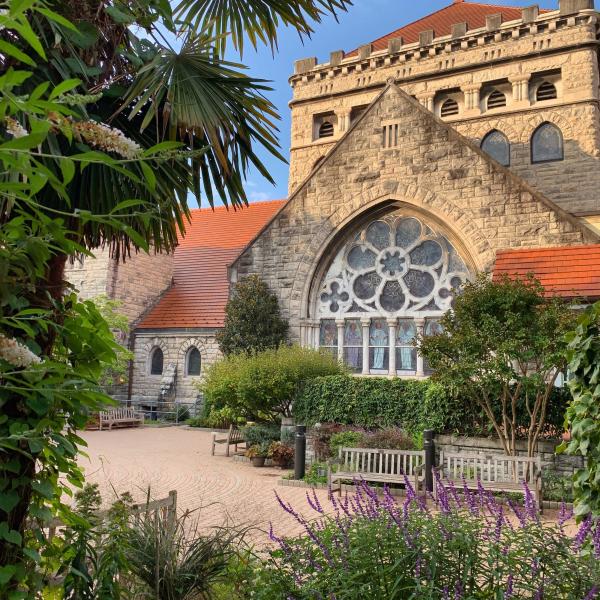
St. John’s Episcopal Cathedral
If you’ve attended Big Ears Festival, you have likely seen a performance at St. John’s. This downtown church can be seen while experiencing the Historic Downtown Knoxville Walking Tour. The first Episcopal services held in Knoxville took place in 1826, thirty-five years after the founding of this pioneer town. In 1844, with 25 communicants, St. John’s became the first mission from the eastern part of the state to be admitted to the Diocese of Tennessee.
A lot on the corner of Cumberland Avenue and Crooked Street (now Walnut) was purchased by the new parish. This site was a part of the original plot plan, which was laid out shortly after the founding of Knoxville. When construction was completed on the first Church building in 1846, a red brick Neo-Gothic structure, this site was almost exactly in the middle of the growing town, which had a population of about two thousand at the time. In 1891 the original building was pulled down and the present larger building was completed the following year. After a devastating fire in the Church in 1919, in which many of the original stained-glass windows were destroyed, the building was promptly restored.
The building’s prototype was the Romanesque churches of the 11th and 12th century France and northern Spain. This style is characterized by massive, rusticated stone surfaces and expansive rounded arches. Detailing is usually rather plain and simple with very little ornamentation. Although there is some employment of Neo-Gothic detailing at St. John’s, particularly in the woodwork and the pointed arched windows, the overall feeling of the structure is unmistakable Neo-Romanesque.
View a full list of churches in Knoxville.
*Check with their websites directly to confirm service times

